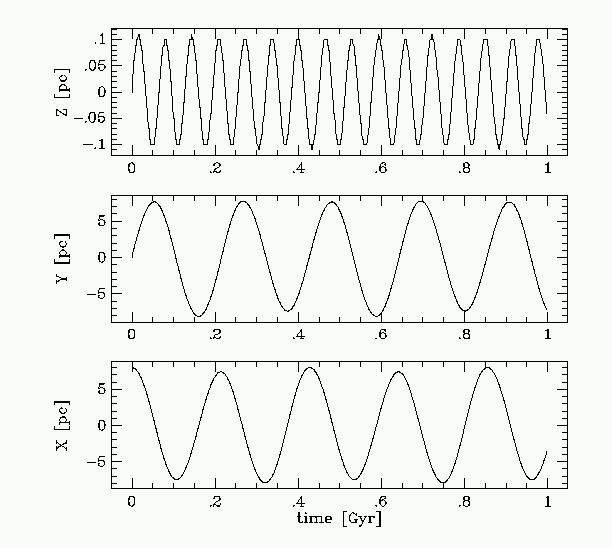
In lecture 7 we looked at how disk stars move around the Galactic center. Young stars have a low velocity dispersion and are therefore on near circular orbits, while old disk stars have greater deviations from circular orbits due to their higher velocity dispersion. Old disk stars may move over several kpc in the radial direction while orbiting the Galactic center.
What about the vertical motions of the stars? Below is a plot of the X, Y and Z motion of a star in a model Galaxy potential. The (U, V, W) velocities were (10, 218.5, 10.0) km/s. Note that the star oscillates in the Z direction much faster than it does in the two (planar) directions.

The oscillations in (X,Y) and Z appear so different because in the (X,Y) plane, the motion is dominated by the high velocity V around the Galactic center ather than the small random velocities relative , whereas in the third direction, Z, the motion is dominated by the small random W velocity.
The oscillation of stars vertically gives us an elegant method to measure the amount of mass near the Sun in the Galactic disk. The disk is a very flat system, and to a good approximation we can split Poisson's equation
∇2Φ = 4πGρ
into planar (i.e. radial) and vertical components. Here it is for a cylindrical (axisymmetric) coordinate system:
(1/R) d(R dΦ/dR)/dR + dΦ/dz = 4πGρ(R,z).
We can express the gradient of the potential as two force components, denoted FR and Fz in the radial and vertical directions respectively.
(1/R) d(R FR)/dR + dFz/dz = −4πGρ(R,z).
Now we have already associated the radial force with the circular speed, V2/R = −FR, and as we know from observations, the circular speed curve of the disk is flat (i.e. hardly varies with radius). The first term on the LHS is thus small, and the local density distribution in z can therefore be related to the vertical force on the stars by
4πGρ(z) = −dFz/dz.
The physical reason that this approximation is quite accurate is that (1) the disk is very thin, so that the vertical and radial oscillations of the stars are very close to being independent, and (2) the rotation curve of the disk is flat, so that the radial force makes only a small contribution in Poisson's equation. One might note that the physical reason for the flatness of the rotation curve is unknown, since it is apparently composed of a falling rotation curve due to the matter distribution in the disk, and a rising rotation curve due to the matter distribution in the dark halo, with the two balancing each other to give a "flat" rotation curve (this is known as the "disk-halo conspiracy").
How do we measure the vertical force Fz on stars as a function of their height above the Galactic disk, in order to apply the equation?
Consider the stars as they oscillate vertically in the potential field of the local disk.
The simplest way to estimate the vertical force would be to measure the Z-motion of a star during an orbital half oscillation. However, for stars near the Sun this turns out to be between about 50 and 100 million years -- much too long to wait.
Since this is out of the question, the method used is to measure statistically the motions of hundreds or thousands of stars in the Potential as a function of their height above the plane i.e we use the Jeans Equation.
Fz = −(σ2/ρ) (dρ/dz).
We can measure the vertical density distribution and the velocity dispersion of a group of stars then we can derive Fz and hence the total density of matter. Note that this assumes the stars are isothermal. This make the following much simpler, but if the stars are not isothermal the equations can still be solved with a bit of extra work.
It's easier to see if we use the combined Poisson-Boltzmann equation (see last lecture)
d[(1/ρ) d(ρ(σ2)/dz]/dz = −4πGρ
There is a complication however. The disk is made of a range of components with different velocity dispersion and hence scale heights. the simplest way to deal with this is to assume that each component can be modelled as an isothermal disk, and we can then add all components (self-consistently) together to obtain the total gravitational force. One particular well studied component can be used to compare theory and observation.
This kind of measurement has been made many times, for many types of stars over the last 60 years, and can be considered a classical problem in astronomy. Two recent studies are of K dwarf stars and K giant stars, large samples of which have been measured at the Galactic poles. The density and velocity distributions can be observed directly, by counting stars on one hand as a function of distance, and by measuring radial velocities.
The result is that the total gravitational potential of the disc near the Sun is generated by about 0.10 +/- 0.01 solar masses per cubic parsec.
This is very close to the actual amount of matter which is seen directly from E-M radiation (e.g. optical, UV and IR for stars, radio for gas) which is also about 0.11 solar masses per cubic parsec.
Inventory of the Solar Neighbourhood
| Component | volume density | vertical
velocity dispersion |
surface density | |
| Mo pc-3 | km s-1 | Mo pc-2 | ||
| Gas | Molecular Hydrogen H 2 | 0.021 | 4.0 | 3.0 |
| Ionised Hydrogen H I | 0.0282 | 8.0 | 8.0 | |
| warm gas | 0.001 | 40.0 | 2.0 | |
| Stars | giants | 0.0006 | 17.0 | 0.4 |
| MV < 2.5 | 0.0031 | 7.5 | 0.9 | |
| 2.5 < MV < 3.0 | 0.0015 | 10.5 | 0.6 | |
| 3.0 < MV < 4.0 | 0.0020 | 14.0 | 1.1 | |
| 4.0 < MV < 5.0 | 0.0024 | 19.5 | 2.0 | |
| 5.0 < MV < 8.0 | 0.0074 | 20.0 | 6.5 | |
| MV > 8.0 | 0.014 | 20.0 | 12.3 | |
| white dwarfs | 0.005 | 20.0 | 4.4 | |
| brown dwarfs | 0.008 | 20.0 | 6.2 | |
| stellar halo | 0.0001 | 100.0 | 0.6 |
The solution shown in the plot has been obtained numerically, by calculating the total gravity of the system described in the table. In practice this means solving a system of Poisson-Boltzmann equations : each component of the model "i" is described at z=0 by a local density ρi and a local velocity dispersion σi. For each component there is an equation:
d[(1/ρi) d(ρi(σi2)/dz]/dz = −4πG Σ &rhoi;
The total density of the system appears on the RHS as Σ ρi.
In the plot below black is the total amount of matter, blue denotes the gaseous components, red the young stars and green the old stars.
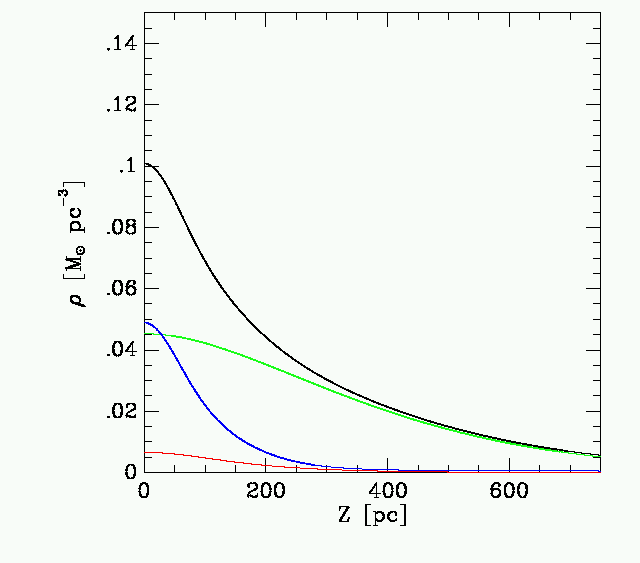
Knowing the amount of matter locally, we can calculate how fast the Sun oscillates vertically in the potential of the Galactic disk. The force law downward on the Sun generated by this disk model is shown below:
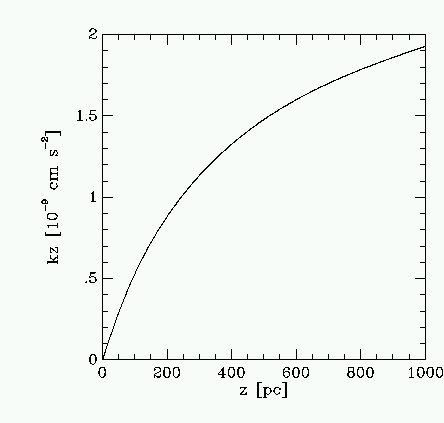
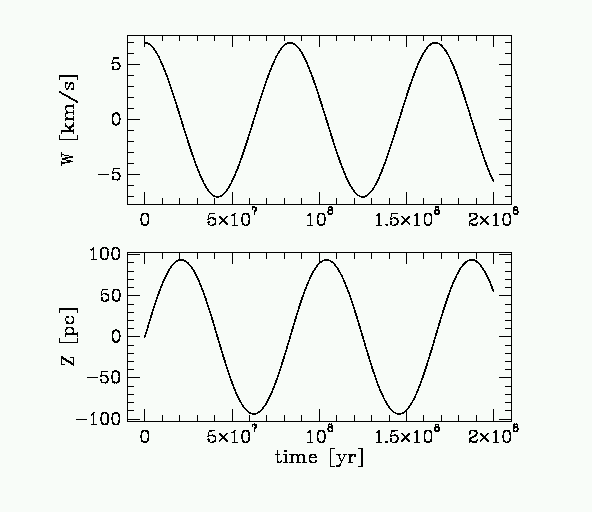
Examination of the number of species (plants and animals) on the Earth as a function of time has shown that there may be a periodicity in the mass extinction (global loss of large numbers of species) of about 25 to 35 Myr. This is quite close to the oscillation of the Sun up and down in the Galactic disk. These two phenomena might be connected as follows.
Passage of the Sun through the Galactic disk causes a tidal force to act on the cloud, sending more comets into the inner solar system where some can eventually hit the Earth.
From the web site of John Matese, University of Southwestern Louisiana (http://www.ucs.louisiana.edu/~jjm9638/)
Evidence for the effect of the background tidal field due to the disk can be seen in the following plot of the location of comet perihelia on the sky (in Galactic coordinates): The pronounced deficiencies at the galactic equator and at the galactic poles are characteristic of the galactic interaction which is minimal at these locations.
The main evidence for periodicity is in the species extinction data and the craterisation of the Earth (although for less than a dozen, large, well dated crates). The difficulty with this scenario is that the recent data, which measure the mass of the local disk using Hipparcos (shown above) yield a solar half-period of 42 Myr, rather than the earlier values, based on much less accurate data, of 25-35 Myr. The above scenario is therefore still definitely an open question.
The most striking feature of disk galaxies is their spiral structure.
Why study the spiral arms?
Surprisingly, spirals are not very well understood, despite 50 years of work on the matter. Initial expectations were that they were quite simple, but this has turned out not to be the case.
One of the pioneers was a Swede, B. Lindblad, who correctly surmised that spiral arms are gravitational phenomena, although this idea wasn't demonstrated satisfactorilly until after Lindblad's death in 1965. Up until that time, ideas centered on magnetic fields as being responsible for the spiral structure. We now know that the magnetic fields in galaxies, although present, are too weak to cause spiral arms.
Spiral arms are a gravitational phenomenon, arising in the dynamical behaviour of self-gravitating disks. They can be regarded as density waves, which propagate in the collisionless stellar medium which forms the disk. In this sense they are much the same as 2-D waves which form on surfaces, such as the ocean or on a drum. Density wave theory was proposed by Lin and Shu in the 1960s.
Broadly spirals are divided into normal spirals and barred
spirals. There are about the same number of barred as normal spirals in
nearby galaxy samples.
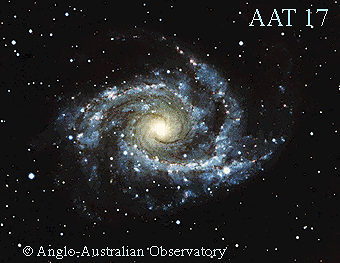 |
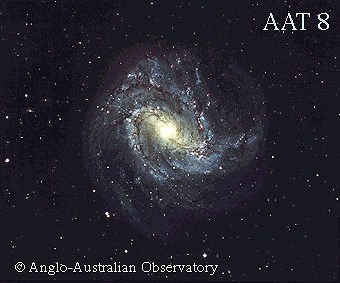 |
These two classes are further subdivided into three categories, depending on how tightly the spiral arms are wound - a, b and c.

Observationally, it turns out that the number and how tightly the spiral arms are wound are well correllated with other, large scale properties of the galaxies, such as the luminosity of the bulge relative to the disk and the amount of gas in the galaxy. This clearly suggests that there are global physical processes involved in spiral arms.
Grand design Spirals
Highly symmetric, often exhibiting 2 arms which wind very regularly,
grand design spirals seem to involve some global process which invloves
the whole galaxy in the formation of the structure. Some grand design spirals
are clearly caused by interaction with a nearby galaxy, which provides a
disturbance in the (previously) stable gravitational field. The following image
is of M100, a classic grand design spiral.
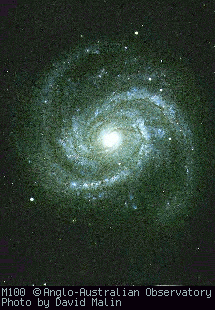 |
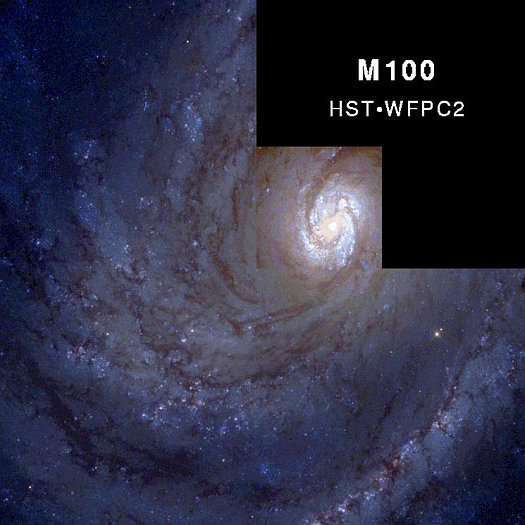 |
Shown on the right are the central regions of a grand design spiral, M100. The features in the center are very regular, and can be followed almost all the way in. Dust lanes along the inner edges help delineate the arms.
Much deeper images by David Malin of the Anglo Australian Observatory reveal that M100 extends a long way out, reaching to interact with satellite galaxies in its vicinity:
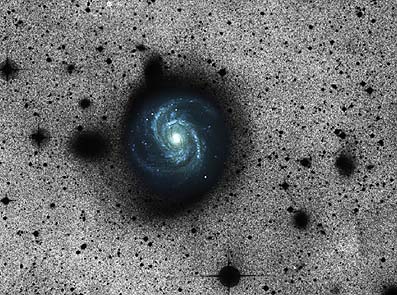
A more obvious case of interaction with a neighbour producing spiral structure is M51: there is a clear bridge of stars between the primary galaxy and the companion.
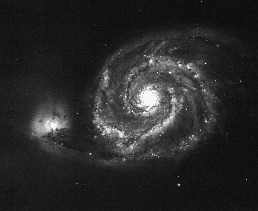
The following Space Telescope images show the regularity of the central
regions, inner dust lanes along the arms and HII regions (sites of recent star
formation).
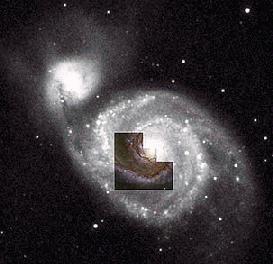 |
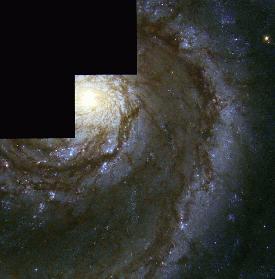 |
Shown below is NGC 1300, a dramatic barred spiral. From BT: The two arms are
very symmetric, although not perfectly so. They can be followed here over 180
degrees, and on deeper images 360 degrees. There are sharp, straight dust lanes
which extend outward from the central region along the bar. At the ends of the
spiral arms there are clusters of HII regions. The spiral arms start at the end
points of the bar suggesting that bars and spiral arms are
related.
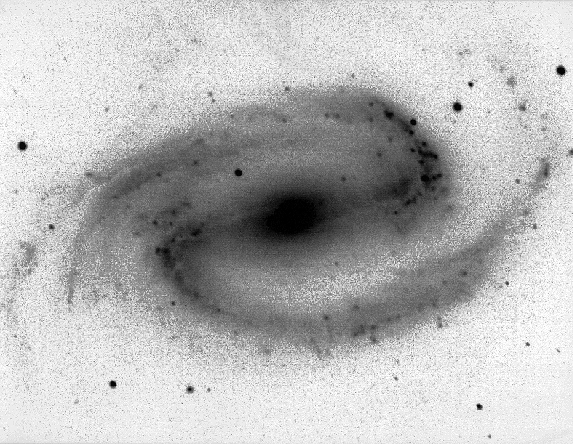
Source : http://www.cv.nrao.edu/~eschulma/n1300.html
Flocculant Spirals
Most spirals do not show the dramatic overall structure typical of grand design galaxies. Typically spirals contain many small short spiral arms which are not corellated on opposite sides of the galaxy. This would seem to indicate that the arms are formed by some local rather than global process. A good example is NGC 2841:
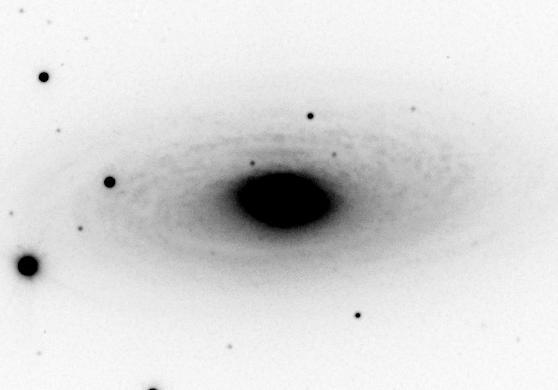
Source http://www.ccdimaging.com/ngc2841.html
More common than either grand design or flocculant spirals are galaxies like
M33, which show loosly wound spirals which sometimes break up into multiple
arms, and cannot be unambiguously traced outward.
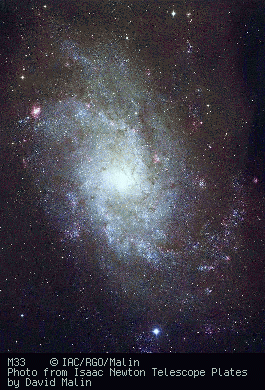 |
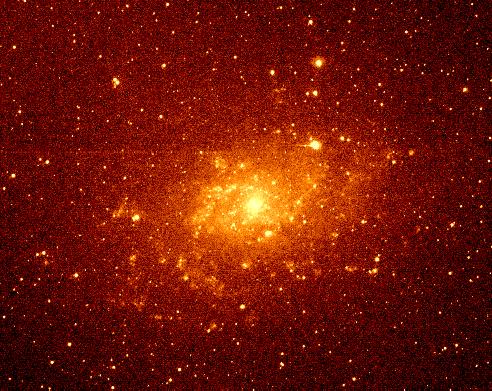 |
Sources: http://www.seds.org/messier/m/m033.html
and http://aibn47.astro.uni-bonn.de/~gallery/galaxies/m33-d.html
Irregular or Peculiar "Spirals"
Some galaxies are classified as spirals on sky survey photographs but, when looked at more closely, are found to be interacting or merging pairs of galaxies : eg NGC 3256.. We'll look further at these in a later lecture.
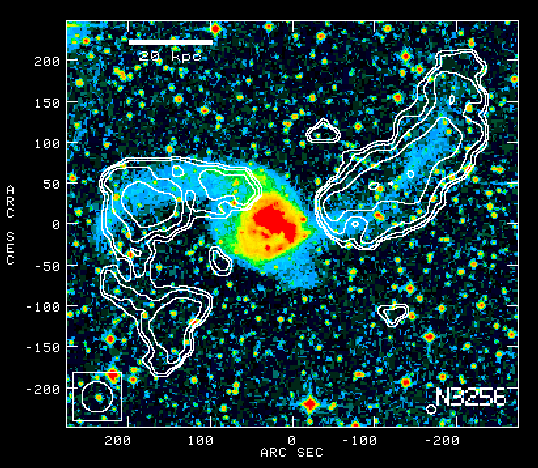
Source http://www.cv.nrao.edu/~jhibbard/TSeq/TSeq.html
HI in white contours on optical image in false spectral colors.
Images in this section from http://www.maa.mhn.de/Messier unless otherwise noted.